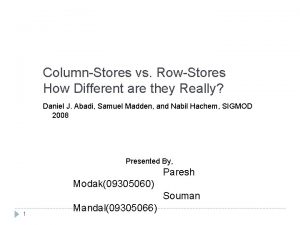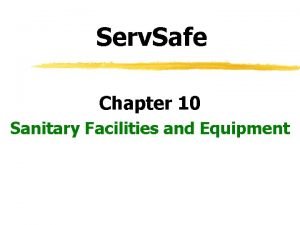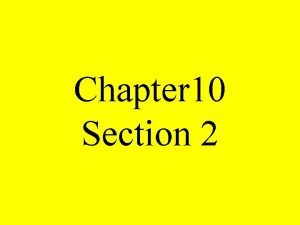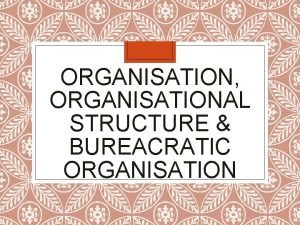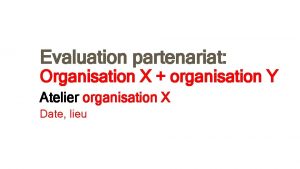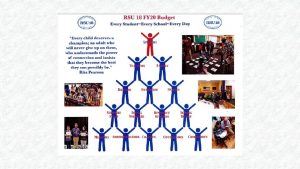Meaning Of Store and Store Keeping Every organisation
















- Slides: 16

Meaning Of Store and Store Keeping �Every organisation has a separate place for storage of materials is known as a store. �The person incharge is called a Store Keeper. �Store keeping is concerned with physical storage of goods.

Objectives Of Store Keeping � 1. To ensure uninterrupted supply of materials and stores without delay to various production and service departments of the organisation. � 2. To prevent overstocking and understocking of materials. � 3. To protect materials from pilferage, theft fire and other risks. � 4. To minimise the storage costs. � 5. To ensure proper and continuous control over materials. � 6. To ensure most effective utilisation of available storage space and workers engaged in the process of storekeeping.

Functions Of a Store Keeper � 1. Issuing purchase requisitions to Purchase Department as and when necessity for materials in stores arises. � 2. Receiving purchased materials from the purchase department and to confirm their quality and quantity with the purchase order. � 3. Storing and preserving materials at proper and convenient places so that items could be easily located. � 4. Storing the materials in such a manner so as to minimise the occurrence of risks and to prevent losses due to defective storage handling. � 5. Issuing materials to various departments against material requisition slips duly authorized by the respective departmental heads.

Stores Accounting and Documents Used MEANING Stores Accounting refers to the process which reveals the quantity, quality and value of stores carried and prreserved in a storehouse on a given date relating to the specified period.

Bin Card � Bin card is a record of receipt and issue of materials Quantity of store received is entered with receipt column and the quantity of store issued is recorded in the issue column of Bin Card. Balance of quantity of stores is ascertained after every receipt or issue. It shows the balance of the stock at any moment of time. Bin Card is maintained by the store-keeper. He is answerable for any difference between physical store and the balance shown by the Bin Card. Thus Bin Card does not only records the receipt an issue of the stores but also assist the store keeper for control of the stock. For each item of stores minimum level maximum level, and ordering level are shown in the part of the Bin Card. By seeing the Bin Card the store keeper sends the material requisition for the purchase of materials from time to time.

Format

Stores Ledger A stores ledger is a manual or computer record of the raw materials and production supplies stored in a production facility. It is maintained by the person responsible for these assets, such as the warehouse manager. A stores ledger is particularly useful for maintaining a perpetual inventory system, since it tracks the current quantity of items on hand. A stores ledger can be used for the following purposes: � By auditors, to see how well the company's inventory records compare to its on-hand quantities. � By the purchasing staff, to determine when and in what quantities to purchase additional inventory items. � By the accounting staff, to use as the basis for calculating the ending cost of inventory on hand.

Format


Location and Layout of Stores Factors Determining Location And Layout of Stores 1) Nature of Material 2) Flexibility 3) Ensuring free flow of material 4) Minimisation of material handling efforts 5) Proper safety measures 6) Decision about centralized or decentralized store house.

Types of stores on basis of Layout Centralized Decentralized Sub storage

Centralized Storage All the materials and supplies are kept at one place. MERITS § Storage space is properly utilized. § Personnel of stores department is fully utilized. § Investments in materials and stores will be minimized. DEMERITS § It increses the cost of material handling. § There is a great loss if in case of fire, pilferage or spoilage.

Decentralized Storage Separate store rooms are attatched to different production departments. MERITS § Transportation cost is generally less § Time saving in transportation. DEMERITS § There will be duplication of items § It will increase in labour cost

Sub Storage Combination of centralized and decentralized. MERITS § Production departments get quick supplies from substores. § Risks of fire etc are scattered. § Effective supervision and control DEMERITS § More space is required § Lack of uniformity in stores organization.

Codification of Materials One of the most important factors in dealing with the materials is the human element which cannot be ignored or bypassed in devising any method of identifying or codifying the materials. Hence, every stores management has to look into the problem involving human being as one of the important elements. Before the system of codification came into existence, the normal way of identifying an article in the storehouse is by its simple description. But this was neither satisfactory nor helpful in carrying out various operations speedily and effectively. The description was sometimes vague and may be confusing.

1. Alphabetic System Letters are chosen to represent particular classification. Alphabet code has 26 letters. Each position in the code has 26 possible letters, where relatively few classification are involved, assignment of letter designates is sometimes arbitrarily made. 2. Simple Numeric or Sequence System Numbers are assigned for classification. The obvious disadvantage of this simple numerical sequence is that there are no memory adds incorporated in the system. A good deal of time is wasted in aching for code numbers in materials code books. 3. Combination System Some firms find it advantageous to combine a mnemonic and numerical or decimal system. 4. Block System Blocks of numbers are reserved for specified classifications such as 1700 -1799 for the raw materials and 1800 -1899 for manufacturing parts, etc. The advantage by doing so is that wherever numbers are not assigned, subsequent expansion can be accommodated. 5. Mnemonic System It is an alphabetic system designed with an objective of easy memorization.
 Every country and every nation
Every country and every nation Microsoft mission and vision
Microsoft mission and vision Every nation and every country
Every nation and every country Every picture has a story and every story has a moment
Every picture has a story and every story has a moment Every knee shall bow every tongue confess
Every knee shall bow every tongue confess Every rotarian every year
Every rotarian every year Every child every day
Every child every day Row store vs column store
Row store vs column store Row store vs column store
Row store vs column store Sanitary equipment facilities definition
Sanitary equipment facilities definition Non trading organisation definition
Non trading organisation definition Introductory paragraph for persuasive essay
Introductory paragraph for persuasive essay Keeping an infant safe and well section 7-3
Keeping an infant safe and well section 7-3 Keeping an infant safe and well section 7-3
Keeping an infant safe and well section 7-3 Describe the overall purpose of management.
Describe the overall purpose of management. An institution for receiving, keeping and lending money
An institution for receiving, keeping and lending money Record keeping and budgeting
Record keeping and budgeting








